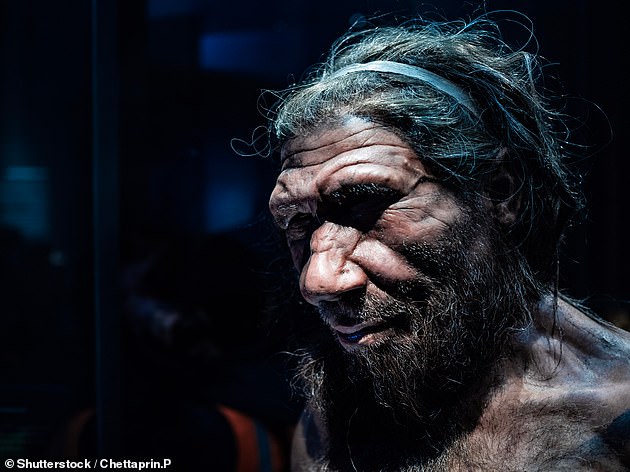DANYAL HUSSAIN and JOE PINKSTONE FOR MAILONLINE

Evidence of the so-called ‘ghost population was found in modern-day people and did not match the genetic fingerprint of Homo sapiens, Denisovans or Neanderthals (pictured, artist’s impression of a neanderthal)
An extinct branch of human ancestry has been discovered lurking inside the DNA of modern-day West Africans which evolved around 500,000 years ago.
Traces of this so-called ‘ghost population’ were located in modern-day people and did not match the genetic fingerprint of Homo sapiens, Denisovans or Neanderthals.
Exactly what species the hominids belonged to is unknown, but humans mated with them around 50,000 years ago, researchers discovered.
No physical evidence — DNA from ancient bones, for example — was found, but a computer model indicates this mysterious species must exist.
Scientists at the University of California in Los Angeles say the unidentified species accounts for up to 19 per cent of the genetic ancestry of four populations in three countries: two from Nigeria, one from Sierra Leone and one from the Gambia
Writing in the study, the authors say: ‘These populations derive two to 19 per cent of their genetic ancestry from an archaic population that diverged before the split of Neanderthals and modern humans.’
The discovery of a new ancient human ancestor is still in its primitive stages.
But early indicators hint that the ghost population shared a common ancestor with Neanderthals, modern humans and Denisovans around a million years ago.
And at some point, up until around 360,000 years ago, it branched off to become its own species.
This group then later bred with the ancestors of modern west Africans around 50,000 years ago, according to the study.
As no physical evidence has been found, the range of dates is still very large.
This mingling of DNA and inter-species mating in Africa between ‘ghosts’ and humans was happening at the same time as Denisovans and Neanderthals were also mating with humans – albeit in Asia and Europe respectively.
The evidence of Denisovans and Neanderthals can be seen today in humans, with all people on Earth having a sliver of neanderthal DNA, while Aboriginal Australians and natives of New Guinea carry chunks of Denisovan DNA.
The stunning find, published in the journal Science Advances, came after the scientists analysed genetic material from 405 people.
It is not the first time ‘ghost DNA’ has been identified in the genes of Africans.
In January, DNA discovered in four skeletons that belonged to children buried at a rock shelter at an archaeological site called Shum Laka in Cameroon also point to the existence of a long-lost ‘ghost’ branch of the human family tree.
All four skeletons inherited about one-third of their DNA from ancestors similar to the hunter-gatherers of western Central Africa.
The remaining two thirds of their DNA, however, came from an ancient West African source, including a ‘long lost ghost population’ previously unknown to science.
This, coupled with the most recent discovery, further complicates the picture of how modern humans evolved.
TIMELINE OF HOW HUMANS EVOLVED AND MATED WITH OTHER HOMINID SPECIES
One million years ago – Homo sapiens (modern humans), Denisovans, Neanderthals and an unidentified ‘ghost’ populations had not yet evolved. All that existed was a single common ancestor.
Some theories claim this may be Homo erectus or Homo heidelbergensis
500,000 to 360,000 years ago – ‘Ghost people’ split off and formed its own species.
700,000 to 300,000 years ago – Neanderthals split from the common ancestor to form its own species and migrated to Western Eurasia
765,000 to 550,00 years ago – Denisovans split and formed its own species and dominated Eastern Eurasia
130,000 years ago – Common ancestors in Africa evolved into what we recognise today as Homo sapiens
100,000 years ago – A large wave of Homo sapiens migrated out of Africa
75,000 years ago – Neanderthals branched westwards and encountered deniovans. These two species subsequently mated.
50,000 years ago – Parts of the Homo sapiens population leaving Africa mated with Neanderthals
50,000 years ago – ‘Ghost’ people species in Africa interbred with Homo sapiens in Africa
50,000 years ago – Denisovans and Neanderthals were mating with Homo sapiens, albeit in Asia and Europe respectively.
40,000 years ago – Denisovans and neanderthals went extinct
30,000 years ago – European and East Asian Homo sapiens populations split
Some Europeans then migrated back into Africa where they mated with native Africans
15,000 years ago – Homo sapiens migrated into the Americas

It is thought that the interbreeding occurred roughly 50,000 years ago, around the same time that Neanderthals were breeding with modern humans elsewhere in the world (stock photo)
Sriram Sankararaman, a computational biologist at UCLA and one of the study’s authors, said: ‘It’s almost certainly the case that the story is incredibly complex and complicated and we have kind of these initial hints about the complexity.’
He admitted that the mystery DNA didn’t belong to Neanderthals or other known groups, such as Denisovans, and said that he and his co-author Arun Durvasula believe it is from a new group entirely.
Sankaraman added: ‘We don’t have a clear identity for this archaic group.
‘That’s why we use the term “ghost”. It doesn’t seem to be particularly closely related to the groups from which we have genome sequences from.’
In their research, they analysed the genomes of the West Africans and used a statistical model to identify different parts of the DNA.
They explained the technique ‘pulls out chunks of DNA which we think are likely to have come from a population that is not modern human.’
Sharon Browning, a biostatistics professor at the University of Washington who has studied the mixing of Denisovans and humans told NPR: ‘The scenario that they are discovering here is one that seems realistic.’
Browning adds the ghost DNA appears frequently in the genetic material which suggests that it is ‘useful’ to modern humans.
However, the study authors admit its unknown what role the ghost genes play in humans who carry them.





